As we celebrate the 40th anniversary of the Endangered Species Act, I thought I would tell a story from back when the City of Portland (Oregon) first was beginning to grapple with the implications of the listing of a species found in our urban environment.
In 1993 residents of the Pacific Northwest had just lived through the spotted owl wars, a decade of conflict where activists literally took to the trees to protect the last of our majestic old growth forests. That spring President Bill Clinton travelled to Portland to hold the Northwest Forest Summit to develop a plan to resolve the forest conflicts. More than 50,000 people rallied in Portland’s Waterfront Park to the music of Neil Young, Phish and others to greet him and raise their voices for the trees. We were still half a decade away from the first listings of salmon and steelhead that would fundamentally change the way we think about our urban waterways. Bald Eagles were slowly making a comeback, but you still had to travel to a local wildlife refuge to see one nesting. Endangered species were something that residents of Portland cared deeply about, but they were still something that was “out there.” Most people had never seen an endangered species.
It was under these circumstances that a pair of peregrines took up residence on Portland’s Fremont Bridge, a giant arch that dominates Portland’s downtown skyline. Although peregrines had been listed under the Endangered Species Act for more than two decades, we had only a handful of nesting pairs in Oregon at that time. The Fremont Bridge pair was OE 26, signifying the it was the 26th eyrie (nest) to be established in Oregon since peregrines began their long road to recovery from the ravages of DDT.


Their arrival was met with….secrecy. Biologists, used to keeping the location of wild land nest sites confidential, applied the same logic to falcons on a downtown city bridge. They watched quietly as the falcons courted and played house throughout the 2003 nesting season, but went away disappointed when no eggs ever materialized. However, in 2004, the falcons produced a single eyas (nestling) on a steel plate on the underside of the bridge, high above Portland’s east side industrial area. Rather than gravel, peregrine’s preferred nesting substrate, they hollowed out a scrape (nest) amid hard balls of pigeon poop that had accumulated on the bridge structure.

That first year of nesting, their nestling fledged prematurely. On the cliffs that peregrines typically nest upon, air currents rise in updrafts and tend to keep young peregrines ledge-bound until they are ready to fly. However on bridges, the cold water moving below causes downdrafts. As young peregrines become more active, the combination of descending air currents and poor nesting substrate tends to suck peregrines off the ledge and out of the sky.
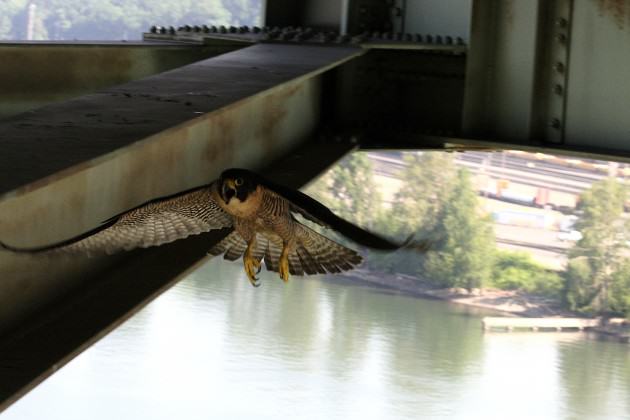
Years later, a worker beneath the bridge would tell me of this young bird’s adventures when she first hit the ground. I was struck by how knowledgeable and aware of the falcons the local workforce appeared to be—truckers and dockworkers below the bridge were often a good source of information on the comings and goings of the falcons. Apparently she landed among small mountains of sand and gravel being loaded onto barges below the bridge, the last flecks of white down still covering the top of her head. Several workers noticed her on the ground, and gave her a wide berth. One shift supervisor, however, decided to get a closer look. Despite the admonishments of other workers to “just leave her alone” he made his way over to her. As he towered over her, falcon looking up and man looking down at falcon, mom came screaming out of the sky in a full stoop (dive) and cold clocked him. Chuckling, the worker who told me this tale, noted, “Any bird that knocks my boss on his ass is okay with me.”
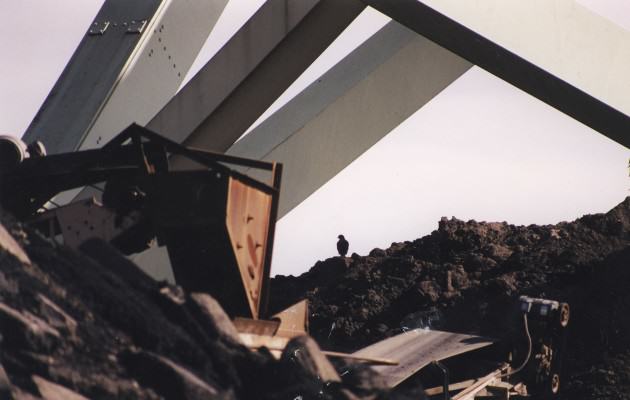

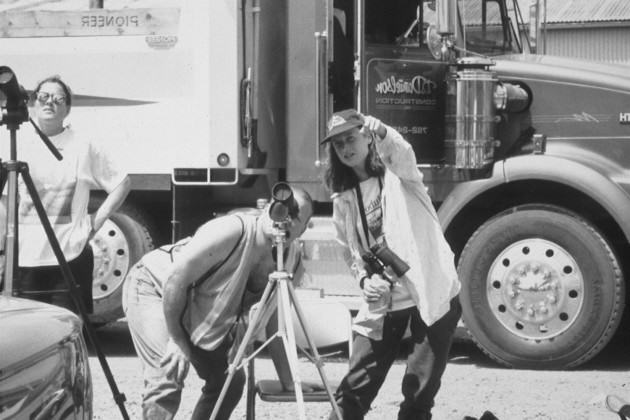
That bird did eventually get airborne, but a week later she slammed into the window of a Rolls Royce dealership a few miles from the Fremont Bridge. She was reported by a homeless person who borrowed change to use a payphone. By the time the information was relayed to me at Audubon, a true game of “telephone” had occurred–all we were told was an that there was an injured falcon standing on the sidewalk somewhere near downtown Portland. We were pondering this information when the phone rang again. This time it was my friend Rick Yazzalino, a keeper at the Oregon Zoo. He shrieked into the phone that a peregrine had hit a window near downtown Portland.
“Yeah, we got that call too,” I told him, “but we don’t know the location, and it probably isn’t a peregrine…you know there is only one pair in the city.”
“Oh its a f@#!ing peregrine all right,” he screeched back, “and it’s in my back seat coughing up blood all over the place.”
We were able to repair that bird and successfully return her to her parents within a few weeks, but the travails of 1994 had left their mark. In the ensuing year, serious discussion began about removing either the eggs or nestlings from the Fremont Bridge and fostering them into a remote nest site on the Mt. Hood National Forest. Peregrines were too precious to be left to the vagaries of the urban landscape.
Audubon pushed back hard on this proposal—after years of battles over spotted owls, we felt that it was important that urbanites not only have the opportunity to see an endangered species, but also to participate in its recovery. Eventually the decision was made to leave the falcons on the bridge. Audubon agreed to monitor them and try and keep them out of trouble during the hazardous fledging process, although we had little idea of what that might actually entail. Also, in a decision that seems obvious with nearly two decades of hindsight, but which was debated at the time, we decided to do public outreach and introduce the community to the falcons nesting in their midst.
In 1996 the falcons moved their nest from the east end of the bridge to a mirror site on the west end of the bridge. Whereas the east side of the river is industrial and blue collar, the west side is much more white collar and in 1996, was on the precipice of exploding into Portland’s most trendy, upscale neighborhood, the Pearl District. A small stretch of the Willamette River Greenway runs beneath the bridge, extending out about a quarter mile or so before dead-ending. The Willamette River Greenway aspires to be a continuous riparian buffer and trail extending the entire 187-mile length of the Willamette River, but in Portland, it is disjointed and fragmented. This particular stretch is really not much more than a sidewalk running atop a seawall. There is little that is green. For most of the year it is used primarily by old men fishing for sturgeon and office workers on their lunch break.
In 2006, however, hoards of birdwatchers descended upon this stretch of asphalt. Audubon volunteers set up spotting scopes and an information table. The local media climbed on board with stories with titles like “Falcon’s Crest.” Hippies gathered to play drums and watch falcons hunting pigeons. Fishermen rolled their eyes at first, but eventually grew to enjoy their status as minor celebrities as the assembled throngs would ooh and ahh every time they pulled a prehistoric fish from the primordial muck below.
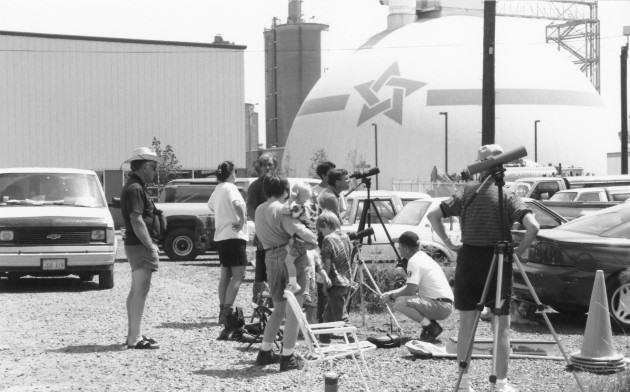
In late May of 2006, three young falcons began appearing on the girders and I-beams that extend outward from the steel plate on which the falcons were nesting. Still covered in a thick layer of down on top of their emerging feathers, they would scurry about, often trying to pass one another on beams that were too narrow for one falcon let alone a traffic jam. As the days went by, they grew more active, furiously flapping their wings and rising a foot or two above the smooth steel…and then scrambling furiously to regain their footing. People began showing-up throughout the day to keep a vigil on the high wire act—would they fly or fall?

The first fledgling hit the ground on June 4th and he picked the worst possible time to drop. Other than sturgeon, peregrines and a quiet place to eat lunch, the only other thing that draws people to this little patch of greenway is the annual Rose Fleet Parade—a procession of military ships that dock in Portland for a few days to signal the start of summer. The Rose Festival was started at the turn of the twentieth century by civic leaders who wanted to establish Portland as the “summer capital of the world.” Today our civic leaders have a more modest aspiration of celebrating Portland’s “volunteerism, patriotism and environmentalism” so maybe this little falcon was onto something after all.
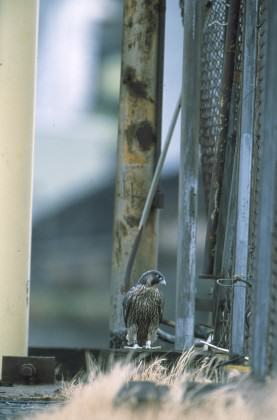
I arrived to find the falcon wandering about on the ground among a sea of parade watchers, his parents flying just above the crowd in tight circles, his siblings watching from the girders far overhead. At nearly that same moment, a SWAT team of uniformed Oregon Department of Fish and Wildlife officials also arrived on the scene. One of them turned to me and said, “I knew we should not have left those damn birds in the middle of the city.” It was determined that the falcon was only a day or two short of being able to take its first flights and the best thing to do was to leave it alone and let its parents care for it on the ground.
I was assigned to do crowd control and was sent off with the quintessential tool of urban endangered species management: yellow caution tape. I quickly set about dividing the greenway into two areas, one for peregrines and the other for people. I spent the rest of the afternoon fielding questions from the public along the lines of “tell me again why we can’t cross this line because of a bird?” and “Does the Audubon Society actually have the authority to shut down the greenway?”

The indelible image from that afternoon that sticks with me to this day is of the young falcon skulking around on the ground—ground-bound peregrines are a very different creature than the agile fliers they soon become after taking to the air—with a cadre of four uniformed Oregon Department of Fish and Wildlife officials tiptoeing along in single file about 200 feet behind him. From my vantage point guarding the yellow caution tape, I would see the little falcon periodically emerge or disappear from behind a building or a dumpster or any number of industrial artifacts that lined the riverfront with the ODFW team a minute or two behind in stealth pursuit. And so it went for the next several hours.
Late that afternoon, my reverie was broken by the sudden appearance of Joe Pesek signaling in the distance for me to come down to where the ODFW team had assembled at the edge of the river. Joe had been our ODFW regional biologist as far back as I could recall. Audubon archives have pictures of generation after generation of Audubon staff working with Joe through the decades. Normally staid and laid back, Joe was about as animated now as I had ever seen him.
“The falcon is gone!” he announced.
“What do you mean he is gone Joe?” I asked. “You all have been following him around like deranged bird stalkers all afternoon.”
“He’s gone,” he insisted. “He just disappeared.”
As best we could tell the falcon had not fallen in the river and he was too young to really take to the air. But as night fell, our bird was still nowhere to be found.
I arrived back at the bridge the next morning about a half hour before sunrise. I wanted to get there when it was still quiet and watch for the parents coming down to feed our missing bird. I wasn’t alone however. As I stood at the edge of the river scanning with my binoculars, a steady procession of homeless people emerged from the shadows. One at a time, they made their way to the northernmost part of the greenway, where it terminates under the bridge, and disappeared for several minutes into a small thicket of shrubs that separate the greenway path from the seawall.
As the sun rose over the river, I decided to investigate. Behind the shrubs I found a long narrow crack in the earth, only a few feet wide and perhaps 6 feet long and 7 feet deep where earth had collapsed landward of the seawall. The local homeless community had been using this hole as a latrine. Toilet paper hung from the jagged cement and rebar that jutted out into this gash. At the bottom was a liquid puddle of human feces, and there staring up at me was our missing peregrine.
Joe Pesek pulled in a few minutes later. “I found our bird, I announced as he got out of his car.
He looked at me for a second, and then said, “He’s in that hole full of shit, isn’t he?”
“Yes,” I replied, “down at the bottom.”
Joe sighed, “Well one of us is going to have to go get him.” Joe looked me up and down. I was a good forty years younger and 100 pounds lighter. Without any further discussion he announced, “I will get you a pair of gloves.”
The thing I remember most about that hole is Joe’s voice reverberating above, “Oh my God that looks horrible…oh that is horrible” as the falcon flapped its wings and scurried into the furthest, darkest recesses of the hole, kicking up a small storm of dust and excrement. I held my breath, reached into the darkness and felt a pair of talons latch onto my glove.
45 minutes later, I was sitting on the doorstep of one of our volunteer veterinarians with a five week old peregrine sitting on my lap. She joked that she should probably call the health department to have us both examined. However we both checked-out more or less okay and within days we were able to reunite this young falcon with his parents and siblings.

18-years later, endangered species are no longer an anomaly on our urban landscape. For better and for worse, they are very much part of the fabric of our existence. Peregrines have been delisted and they now inhabit half a dozen local bridges. The Fremont Bridge nest site has fledged more than 55 young and is recognized as the most productive nest site in Oregon. Bald eagles too have returned to our skies. They nest along our river and we get a growing number of reports of them showing up in backyards. The most common injury we see with eagles is from territorial fights between eagles competing for nest sites. We struggle with our role in recovering federally listed salmon and steelhead knowing that our degraded urban waterways create significant impediments to restoring runs on the Willamette and Columbia Rivers. A new listing is on the horizon—streaked horned larks, a bird that most people have never hear of that nests in disturbed grassland habitats near Portland’s airport and industrial area, is proposed for listing.
The days when we debated whether endangered species belonged in the city seem long ago, but not so far away.
Bob Sallinger
Portland








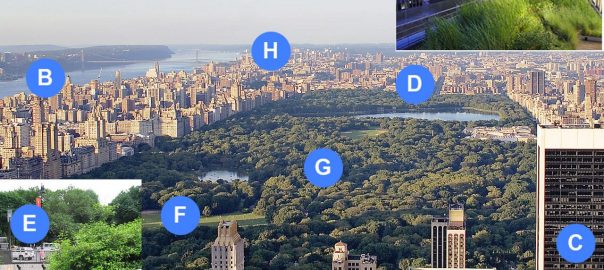


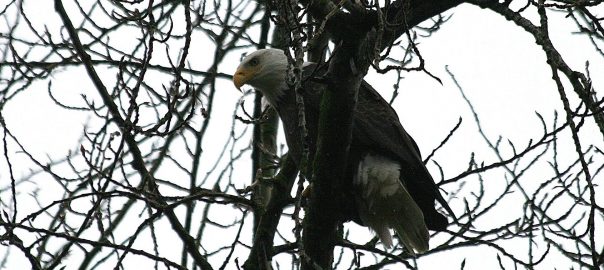
That’s an excellent urban wildlife story, Bob, both entertaining and informative, thanks for sharing it.
That was a wonderful, well written story Bob. You are truly making a different for Peregrines and animals in general. I so miss working with you.
Why am I not surprised that you fearlessly jumped into that mess and emerged successfully?
You do it all the time in city and metro council meetings. Thanks for all you do and for a delightful, informative article!!
Excellent job Bob, I really enjoyed reading it.
Wonderful story–truly funny and great example of ESA success in cities!
(also, since these comments get moderated, that second photo of mum in foreground on the girder with dad in the background is mine too! thanks for the photo credit on the pbird in flight.)
thoughtful, entertaining & informative piece on peregrines in our city, bob. the latrine story just never gets old.